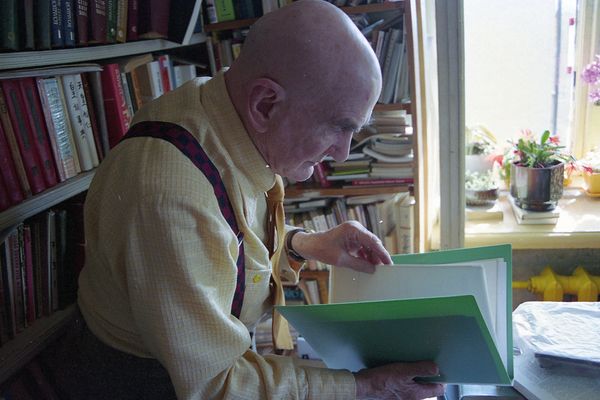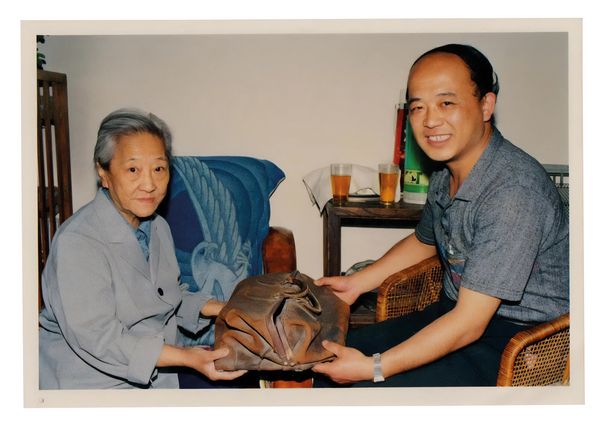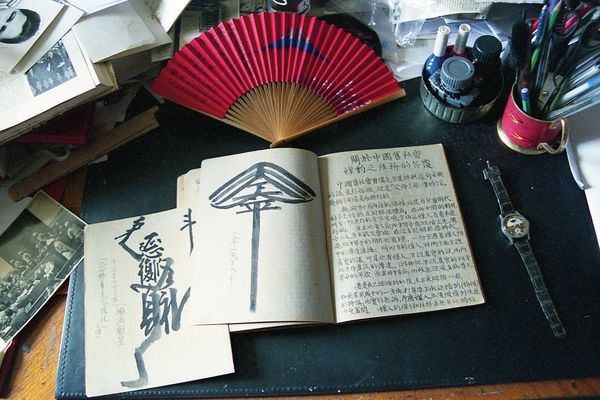Photos taken by Russell Working during an interview with Georgy Permyakov in Khabarovsk in 2001.©Russell Working
When an owner entrusts an auction house with the sale of a treasured artefact, the auctioneer must establish its provenance. In the case of Emperor Puyi’s watch, Phillips launched a research project perhaps unprecedented in the annals of auctions. A worldwide team of watch experts, historians,journalists, and scientists undertook a three-year investigation into the origins of the Patek Philippe Reference 96 Quantieme Lune.
The watch is priceless in its own right—one of only eight known, and one of three with this dial configuration. But its value was heightened with the mystique of its backstory. Aisin-Gioro Puyi, the last emperor of the Qing dynasty, had given the watch to his interpreter while he was imprisoned in the Soviet Union (1945-1950). More than three years later, Phillips has proven the watch’s provenance—as well as that of Puyi’s notebook, a fan he inscribed, and fifteen watercolours by his brother-in-law.
The evidence came in three stages.
1. The Journalists
During an internet search, Phillips’ team discovered an article about Georgy Permyakov, Puyi’s interpreter, that had run in the South China Morning Post in May 2001. A husbandwife team of journalists, Russell and Nonna Working, had interviewed Permyakov and seen many of the items in Permyakov’s home.
Now living in suburban Chicago, they still have the original negatives of Russell’s photos of Puyi’s notebook, the fan, and the watch arrayed together on Permyakov’s desk. These photographs placed the watch and related artefacts in Permyakov’s home two decades earlier, confirming the provenance that the mementos had belonged to the interpreter. Nonna’s further research turned up a memoir article by Permyakov about Puyi, as well other publications in Russian confirming the relationship of the two men.

Photos taken by Russell Working during an interview with Georgy Permyakov in Khabarovsk in 2001.©Russell Working
2. Scientists and Scholars
When the owner entrusted the timepiece to Phillips in September 2019, an internal analysis established that all its parts were all original.
The company also sent the artefacts to ArtDiscovery, a London laboratory that uses radiocarbon dating and microscopic examination to confirm the age of the fan, notebook, watercolours, and other objects. The lab also conducted a literary and stylistic analysis, looking for the hand of Puyi and his brother-in-law in the writing and paintings. This evidence, too, confirmed the provenance.
Yet there was a mystery in the watch dial itself: Someone had removed half of the surface. ‘The first question we had was, “Why is the dial in that condition?” ’ says Thomas Perazzi, head of Phillips watches, Asia. ‘We knew it was not from aging, it was not water damage. We knew that it was done by someone. But we didn’t know who was and the reason.’
The answer would come in a later phase of the investigation. And fascinatingly, the dial itself would help establish the provenance.

In 1983, Puyi's sister, Aisin-Gioro Yunxin, donated Puyi's leather bag he used to carry his treasures, and the recipient of the leather bag was Wang Wenfeng. ©Palace Museum of The Manchurian Regime
3. The Biographer
While the Workings established the Russian provenance, Phillips researched Chinese language sources. This led to Mr. Wang Wenfeng, formerly researcher of the Palace Museum of the Manchurian Regime, the only institute specialising in Puyi’s studies, based in Changchun.
Since 1982 he has devoted his scholarly life to the last emperor of the Qing dynasty.He was familiar with the memoirs by Puyi’s Aisin-Gioro family. In their writings they confirmed that Puyi had given his interpreter the watch, mentioning Permyakov by name.
Furthermore, Wang had interviewed many members of Puyi’s family, including brothers, sisters, nephews, and wives. One conversation with Puyi’s personal attendant, Li Guoxiong, solved the mystery of the dial. One day in their Soviet prison camp, Puyi asked Li to remove the surface of the watch dial to check if it was made of platinum, the servant recalled. When he saw that the surface was not platinum, Puyi told Li to stop.
Finally, the museum sent a team of Chinese scholars to visit the Permyakovs in 2009. They, too, viewed the entire collection there—and confirmed that the watercolours in the collection had been painted by Gobulo Runqi, the notebook written by Puyi during the Soviet prison camp period.
Drawing on these streams of information, Phillips’ patience was rewarded. Confirmation came from physical, literary, and eyewitness sources: the story was true. Puyi gave his interpreter the watch.

A collection of memoirs used for the Imperial Patek Philippe research.
The Watch’s Journey: A Hypothesis
It is a strange twist of horological history that a priceless Patek Philippe Ref. 96 Quantieme Lune would turn up in a rundown Soviet-era apartment in the Russian Far East. The gift of the watch from former emperor Aisin-Gioro Puyi to his Russian interpreter, Georgy Permyakov, in 1950 is clearly documented in Chinese, Russian, and English-language sources. But how did the watch make its way from its manufacture in Geneva to faraway China?

Guillermin advertisement for the Patek Philippe Ref. 96QL in 1937.
Aurel Bacs, senior consultant with Phillips in association with Bacs & Russo, has a theory. Though his hypothesis is unproven, strong circumstantial evidence suggests that it explains the watch’s remarkable journey. Phillips has traced the watch from its manufacture in Geneva to a 1937 sale in Guillermin, a Parisian luxury store then located on Place Vendome, home of some of the world’s leading jewellers. From there, nobody knew how the watch ended up on the wrist of a Puyi in north-eastern China.
Playing historical Sherlock Holmes, Bacs pieced together a trail of purveyors of luxury goods in China and Southeast Asia. These businesses, including Sennet Frères, were interconnected by family marriages, and their reach stretched from Hong Kong to Paris.
‘Please consider that Guillermin was not only retailer with a shop at 20 Place Vendome, but also the sole importer of Patek Philippe into France,’ Bacs says. ‘This means that they were also supplying to other dealers, and likely to export firms like Sennet Frères.’
Sennet Frères is a 150-year-old Hong Kong watch and jewellery brand. Founded in Paris by Albert Weill in 1870, the firm was a major distributor of luxury watches and jewellery when he brought it to Hong Kong in the 1920s.
‘Puyi was a client of theirs and had 14-karat gold glasses retailed by Sennet Frères,’ Bacs says.
Puyi’s spectacles are displayed in a Sennet Frères case in the Palace Museum in Beijing. He took pride in his American Packard automobile, imported by Levy Frères, also called Levy Hermanos, since the business was anchored in the former Spanish colony of the Philippines. This firm was founded by a merchant family of Jewish refugees from Alsace-Loraine who were connected by marriage to Sennet Frères.
Levy Frères/Hermanos becomes an important link in Bacs’ detective story. ‘They were Patek Philippe retailers, too—in fact, their sole agents,’ he says.
Sennet Frères eventually took over the Levy Freres business in Hong Kong and opened branches in Shanghai and Tianjin. The latter city is where Puyi lived in the Japanese concession after fleeing Beijing in the 1920s.
‘Sennet Freres was still around in the 1970s and was my family’s jeweller,’ recalls Pansy Ku, Phillips’ International Business Development Director for Watches. ‘I remember going to their shop at the Mandarin Oriental Hotel and Marina House in Central. They were a French-Jewish family who had a watch and jewellery company and were the purveyor of fine jewellery and distributor for Patek Philippe and Cartier as well as clocks, etc. Evidence from the various luxury goods come together to suggest a path the watch followed in its journey east. The Packard automobile was ‘probably imported by the same company as his glasses, jewellery and Patek Philippe,’ Bacs says.
